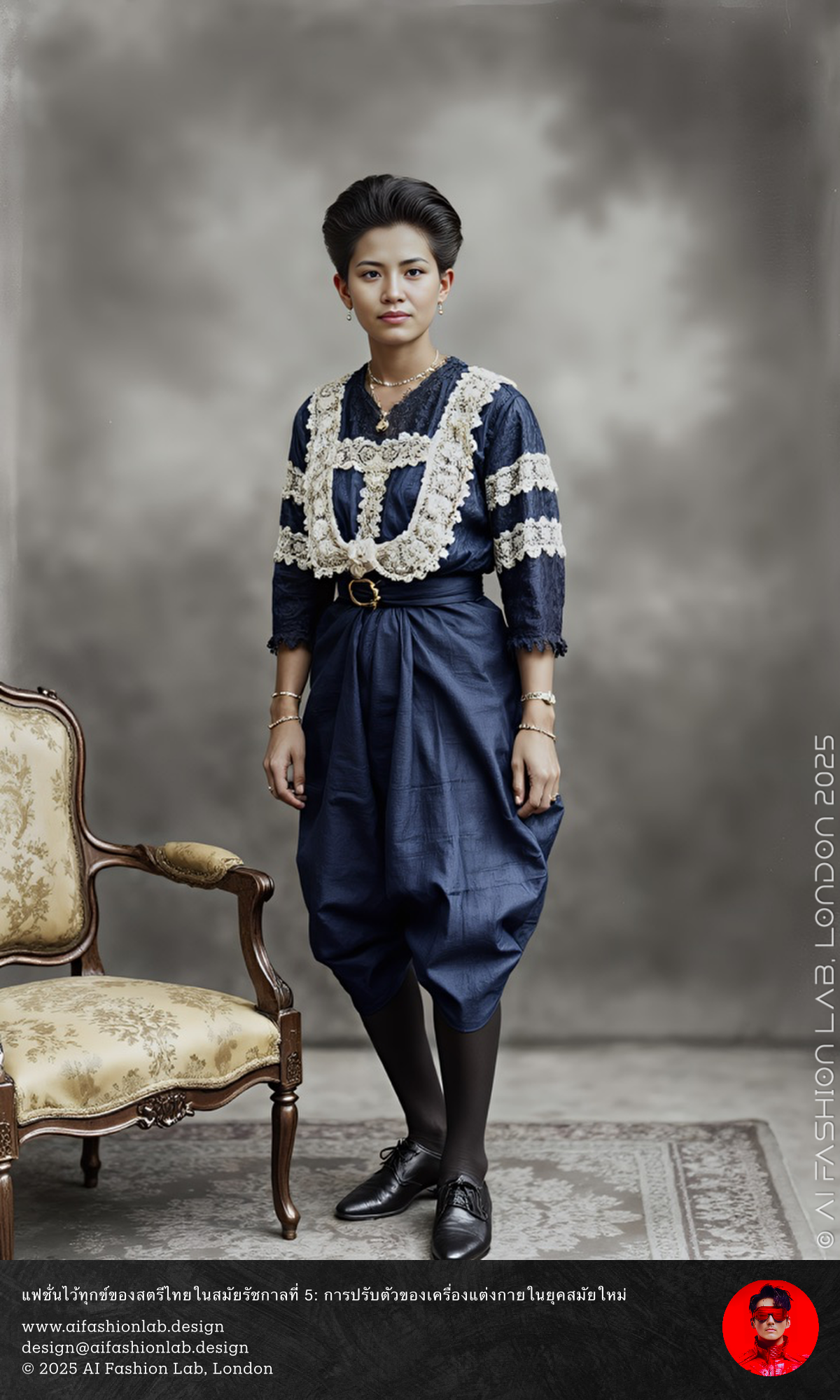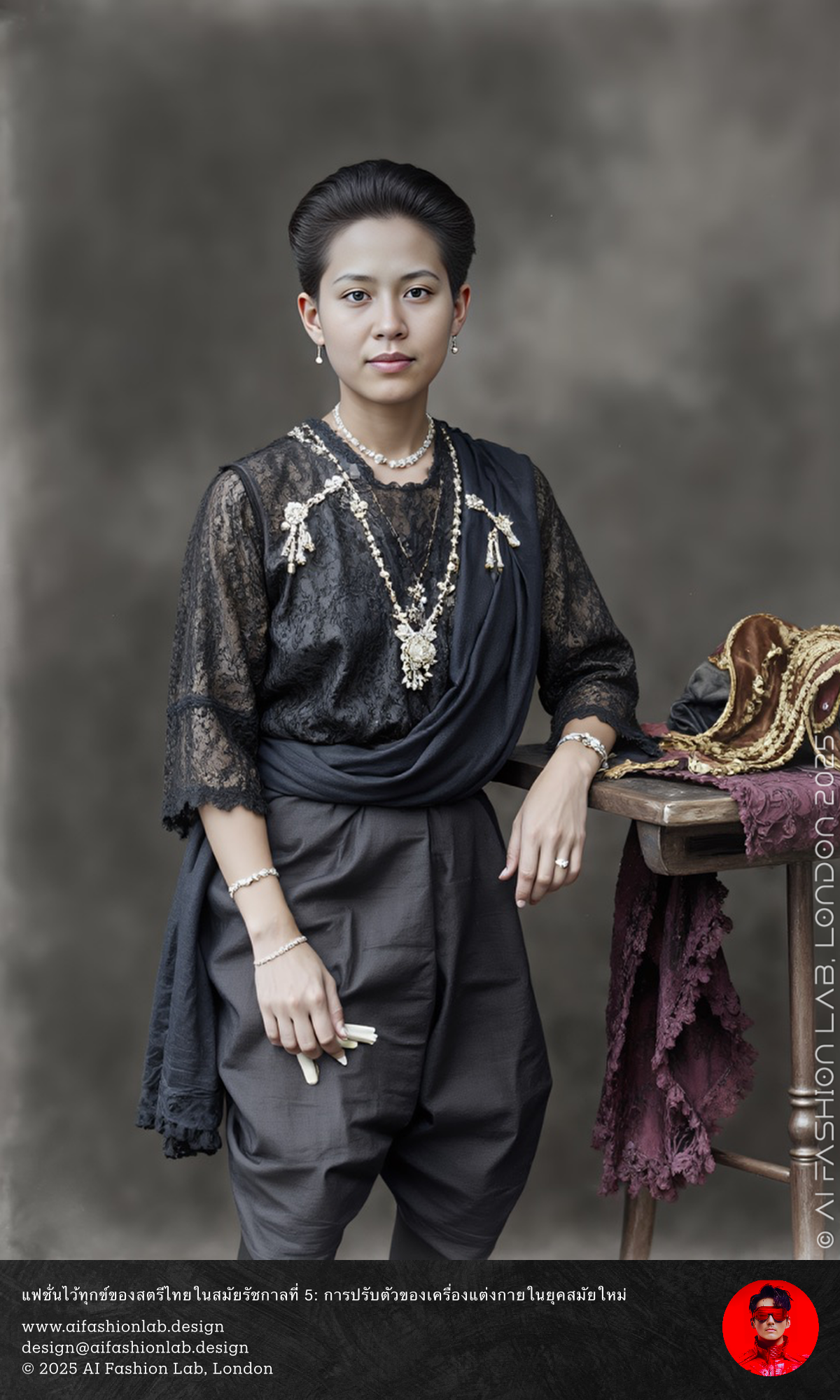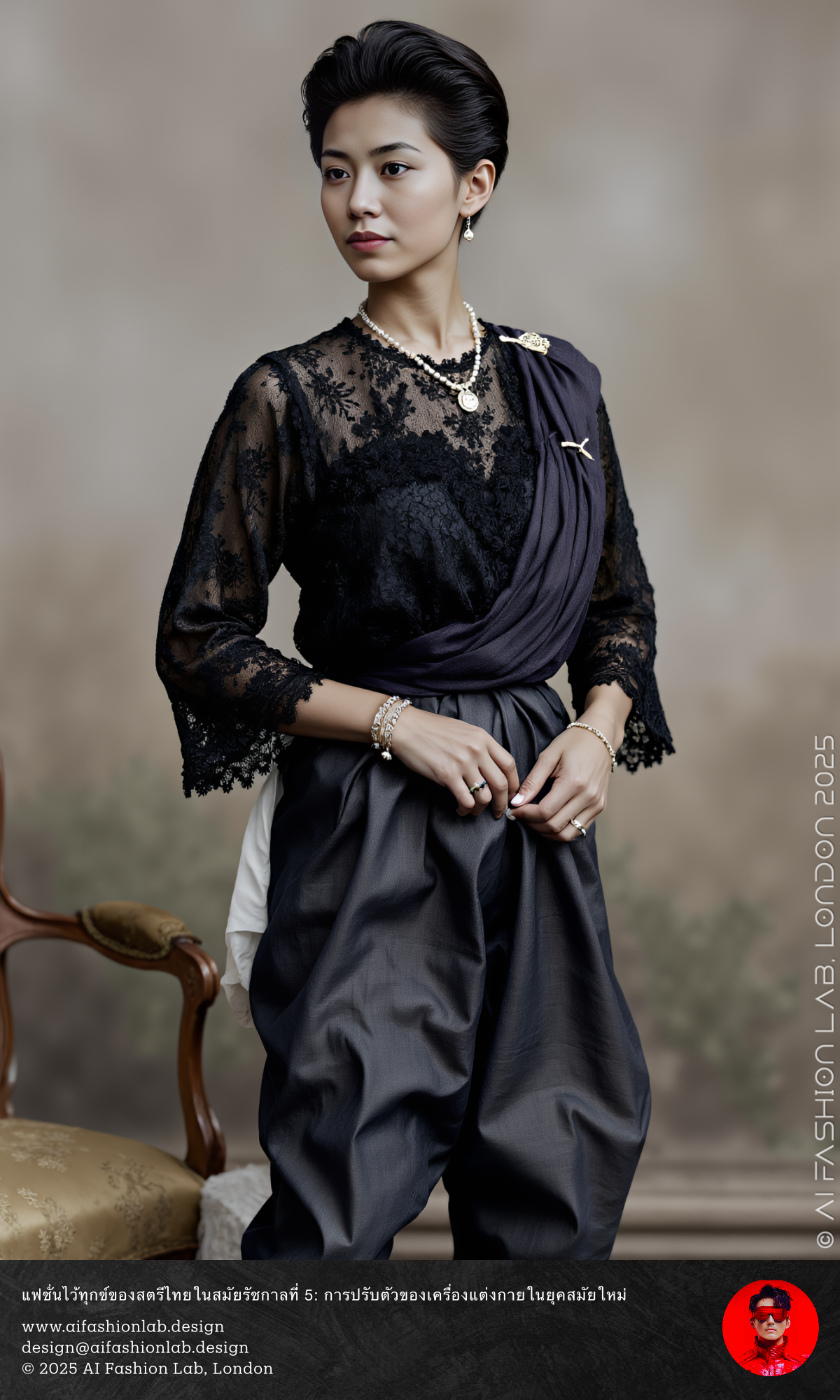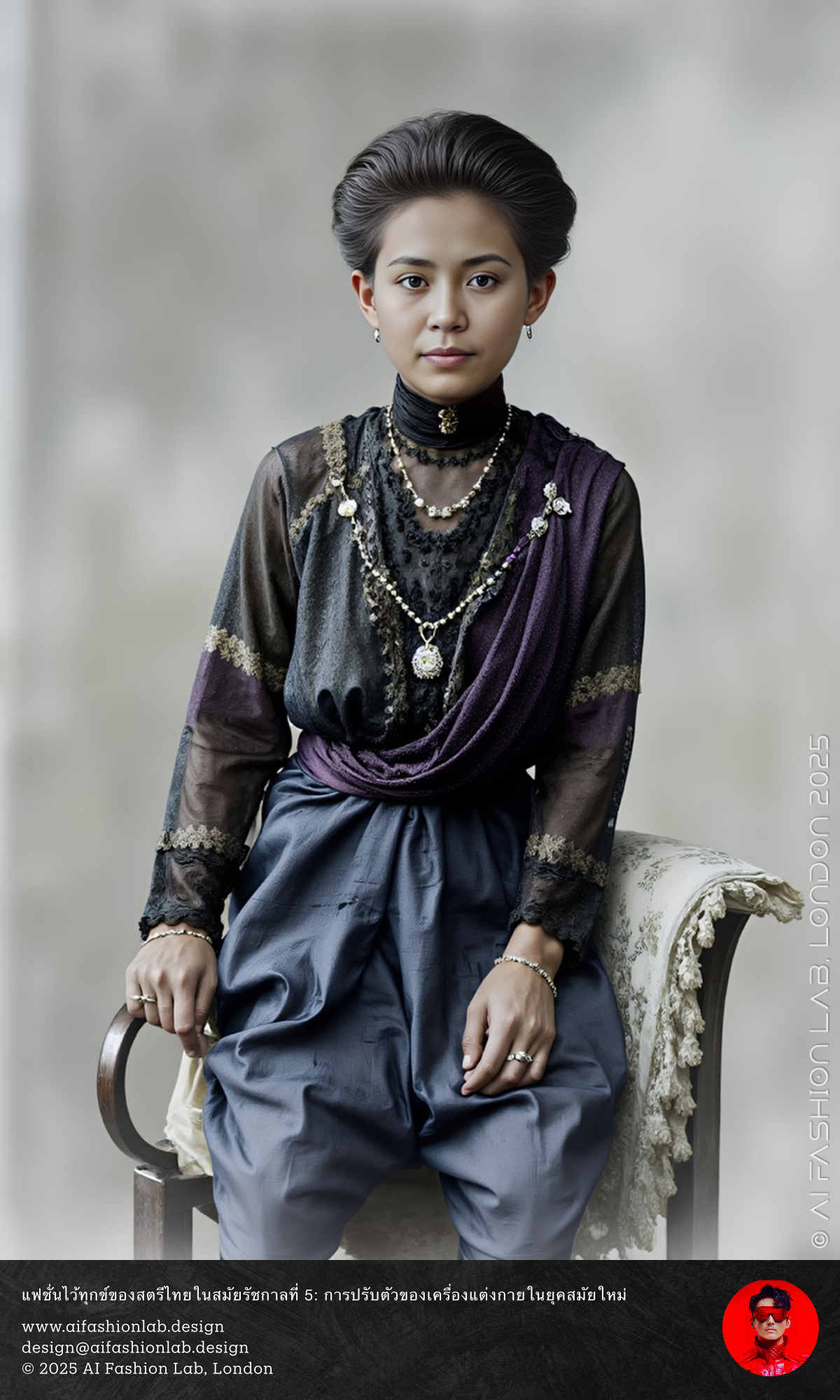Thai Women's Mourning Fashion During the Reign of King Rama V
In the late 19th and early 20th centuries, black began to emerge as a mourning colour in the Thai royal court, influenced by Western mourning traditions. This period coincided with Thailand’s modernisation under King Chulalongkorn (Rama V).
Was Black the Traditional Mourning Colour?
In traditional Thai customs, the primary mourning colour was white, particularly for funeral ceremonies, especially those of the monarchy and nobility. In the past, mourning practices also included shaving one’s head as a sign of deep grief and respect for the deceased monarch.
However, in the late 19th and early 20th centuries, black began to emerge as a mourning colour in the Thai royal court, influenced by Western mourning traditions. This period coincided with Thailand’s modernisation under King Chulalongkorn (Rama V).
The use of black mourning attire in royal funerals was first introduced during the reign of King Mongkut (Rama IV)and later became standard in the Thai royal court after King Chulalongkorn passed away in 1910 (B.E. 2453).
Evolution of Mourning Practices in Thailand
Early Traditions: White Mourning and Head Shaving
In ancient times, both men and women were required to shave their heads and wear white clothing when a monarch passed away.
Shaving the head symbolised grief and the renunciation of personal beauty as a tribute to the deceased.
Anyone who violated this tradition faced severe punishment.
King Mongkut’s Reign (Rama IV): The Introduction of Black Mourning Attire
During the reign of King Mongkut (Rama IV), there was a significant shift in mourning customs. Black was used as a mourning colour for the first time in the Thai royal court.
King Mongkut issued a royal decree requiring members of the royal family and courtiers to wear black at the funeral of Princess Chandrmondol Sobhon Bhakbhadi.
This marked the first formal use of black as a mourning colour in Thailand, following European customs.
King Chulalongkorn’s Reign (Rama V): Expansion of Black Mourning Attire and the Introduction of Additional Mourning Colours
During King Chulalongkorn’s reign, different colours were designated for mourning, based on the mourner’s status:
Black – Worn by elderly mourners or those older than the deceased.
White – Worn by younger mourners or those junior in age to the deceased.
Dark purple or dark navy blue – Worn by those who were not related to the deceased but wished to show respect.
In addition to black, King Chulalongkorn introduced other mourning colours such as khaki, pigeon-grey, and navy blue, which were influenced more by Thai traditions than by Western customs.
King Vajiravudh’s Reign (Rama VI): The Abolition of Head Shaving for Mourning
When King Chulalongkorn passed away in 1910 (B.E. 2453), his successor, King Vajiravudh (Rama VI), issued a royal decree abolishing the practice of shaving one’s head for mourning.
The king viewed this practice as burdensome and an unnecessary hardship for the public.
Mourning Attire in the Royal Court During the Reign of King Chulalongkorn
Mourning Attire for Women in the Royal Court
During this period, women in the royal court adopted Victorian and Edwardian fashion influences while still preserving elements of traditional Thai dress.
Mourning outfits typically consisted of:
Dark-coloured jong kraben (traditional Thai wrapped trousers)
Lace blouses or wide-necked blouses with three-quarter-length sleeves
Dark silk shawls or sashes
The Use of Dark Purple and Dark Navy Blue in the Royal Court
For courtiers who were not direct relatives of the deceased, dark purple and dark navy blue were preferred mourning colours.
Attire reflecting mourning status included:
Purple silk garments
Ivory-coloured silk sashes
Green silk garments
Soft or deep purple silk fabric, depending on personal preference
This tradition reflected the hierarchical nature of mourning customs in the royal court, where different levels of mourning were observed based on the mourner’s relationship with the deceased.
Mourning Attire for Men in the Royal Court
Men did not adopt full mourning attire but instead followed a more simplified approach:
Wearing a black armband over white or light-coloured long-sleeved shirts.
In some cases, wearing a dark-coloured suit for formal occasions.
This practice continued into the reign of King Vajiravudh (Rama VI, 1910–1925) and later became the standard for official mourning periods in Thailand.
Conclusion
White was originally the primary mourning colour in Thailand until King Mongkut (Rama IV) introduced black mourning attire for royal funerals in the mid-19th century.
During the reign of King Chulalongkorn (Rama V), additional mourning colours were introduced, including khaki, pigeon-grey, and navy blue.
Dark purple and dark navy blue were designated for courtiers and those who were not direct relatives of the deceased.
King Vajiravudh (Rama VI) abolished the practice of head shaving for mourning, leading to a gradual shift toward a Western-influenced approach to mourning attire.
Although black mourning attire was influenced by Western customs, the continued use of other colours in Thai mourning traditions reflects Thailand’s ability to integrate foreign influences while maintaining its own cultural identity.
สีดำเป็นสีดั้งเดิมของการไว้ทุกข์หรือไม่?
ใน ประเพณีไทยดั้งเดิม สีหลักของการไว้ทุกข์คือ สีขาว ซึ่งใช้กันอย่างแพร่หลายในพิธีศพ โดยเฉพาะของพระมหากษัตริย์และชนชั้นสูง ทั้งนี้ การแสดงความไว้อาลัยในอดีตยังรวมถึง การโกนศีรษะ ของราษฎรที่ร่วมไว้อาลัยให้แก่พระมหากษัตริย์
อย่างไรก็ตาม ในช่วงปลาย ศตวรรษที่ 19 และต้นศตวรรษที่ 20 สีดำเริ่มปรากฏเป็นสีไว้ทุกข์ในราชสำนัก โดยได้รับ อิทธิพลจากธรรมเนียมการไว้ทุกข์แบบตะวันตก ซึ่งเป็นช่วงที่ประเทศไทยอยู่ภายใต้การปฏิรูปให้ทันสมัยในรัชสมัย พระบาทสมเด็จพระจุลจอมเกล้าเจ้าอยู่หัว (รัชกาลที่ 5)
การใช้ สีดำ ในงานพระศพของราชสำนักมีจุดเริ่มต้นใน รัชกาลที่ 4 และกลายเป็นมาตรฐานในราชสำนักภายหลัง รัชกาลที่ 5เสด็จสวรรคตใน พ.ศ. 2453
พัฒนาการของการไว้ทุกข์ในไทย
ยุคดั้งเดิม: สีขาวและการโกนศีรษะ
ในสมัยโบราณ ราษฎรทั้งชายและหญิงต้องโกนศีรษะเกลี้ยงและสวมเสื้อผ้าสีขาว เมื่อพระมหากษัตริย์สวรรคต
การโกนศีรษะเป็นสัญลักษณ์ของ ความเศร้าโศกและการสละความงามเพื่อถวายความอาลัย
หากใครฝ่าฝืนต้องได้รับโทษหนัก
สมัยรัชกาลที่ 4: การนำสีดำมาใช้ในราชสำนัก
ใน สมัยรัชกาลที่ 4 (พระบาทสมเด็จพระจอมเกล้าเจ้าอยู่หัว) มีการเปลี่ยนแปลงครั้งสำคัญ โดย สีดำถูกนำมาใช้เป็นสีไว้ทุกข์ครั้งแรกในราชสำนัก
พระองค์ทรงมี พระบรมราชโองการให้พระบรมวงศานุวงศ์และข้าราชบริพารแต่งกายด้วยผ้าสีดำ ใน งานพระศพสมเด็จพระเจ้าลูกเธอ เจ้าฟ้าจันทรมณฑลโสภณภควดี
ถือเป็นครั้งแรกที่มีการใช้สีดำในราชสำนักไทย ตามแบบอย่างยุโรป
สมัยรัชกาลที่ 5: การขยายการใช้สีดำและการกำหนดสีอื่นในการไว้ทุกข์
ในรัชกาลที่ 5 ธรรมเนียมไว้ทุกข์ของไทยเริ่มมีการกำหนดสีที่แตกต่างกันขึ้นอยู่กับสถานะของผู้ไว้ทุกข์
สีที่ใช้ในช่วงรัชกาลที่ 5 ได้แก่:
สีดำ – สำหรับ ผู้ใหญ่หรือผู้ที่มีอายุมากกว่าผู้ตาย
สีขาว – สำหรับ ผู้เยาว์หรือผู้ที่มีอายุน้อยกว่าผู้ตาย
สีม่วงแก่หรือสีน้ำเงินแก่ – สำหรับ ผู้ที่ไม่ได้มีความสัมพันธ์เป็นญาติหรือเกี่ยวดองกับผู้ตาย แต่ต้องการแสดงความเคารพ
นอกจากสีดำ สีอื่นๆ ที่ถูกใช้ในการไว้ทุกข์ในรัชกาลที่ 5 ได้แก่ สีกุหร่า สีนกพิราบ และสีน้ำเงิน ซึ่งเป็นสีที่ได้รับอิทธิพลจากธรรมเนียมไทยมากกว่าตะวันตก
สมัยรัชกาลที่ 6: การยกเลิกการโกนศีรษะไว้ทุกข์
เมื่อพระบาทสมเด็จพระจุลจอมเกล้าเจ้าอยู่หัวเสด็จสวรรคตใน พ.ศ. 2453 รัชกาลที่ 6 (พระบาทสมเด็จพระมงกุฎเกล้าเจ้าอยู่หัว) ทรงมีพระบรมราชโองการให้ยกเลิกธรรมเนียมการโกนศีรษะไว้ทุกข์
พระองค์ทรงเห็นว่า การโกนศีรษะเป็นภาระและสร้างความเดือดร้อนแก่ราษฎร
การแต่งกายไว้ทุกข์ของราชสำนักในสมัยรัชกาลที่ 5
สตรีในราชสำนัก
ในช่วงเวลานี้ หญิงในราชสำนักนิยม สวมเสื้อผ้าที่ได้รับอิทธิพลจากแฟชั่นยุควิกตอเรียและเอ็ดเวิร์ด (Victorian-Edwardian Fashion) แต่ยังคงรักษาความเป็นไทยไว้
โดยทั่วไป ชุดไว้ทุกข์ประกอบด้วย:
โจงกระเบนสีเข้ม
เสื้อลูกไม้หรือเสื้อเปิดคอกว้าง แขนเสื้อสามส่วน
สะพักแพรสีเข้ม หรือผ้าคลุมไหล่
การใช้สีม่วงแก่และสีน้ำเงินแก่ในราชสำนัก
สำหรับชาววังที่มิได้เป็นญาติสนิทของผู้ล่วงลับ นิยมแต่งกายไว้ทุกข์ด้วย สีม่วงแก่หรือสีน้ำเงินแก่
โดยมีการใช้เครื่องแต่งกายที่สะท้อนถึงความสุภาพและความเคารพ ได้แก่:
ผ้าทรงสีม่วง
สะพักแพรสีนวล
ผ้าทรงสีเขียว
แพรสีม่วงอ่อนหรือม่วงแก่ ตามที่ชอบ
บุรุษในราชสำนัก
บุรุษไทยในสมัยนั้น ไม่ได้สวมชุดไว้ทุกข์แบบเต็มรูปแบบ แต่ใช้วิธีที่เรียบง่ายกว่า ได้แก่:
สวมปลอกแขนสีดำ ทับเสื้อแขนยาวสีขาวหรือสีอ่อน
ในบางกรณี อาจสวม ชุดสูทสีเข้ม สำหรับโอกาสทางการ
สรุป
สีขาวเป็นสีหลักของการไว้ทุกข์ในไทยแต่เดิม ก่อนที่ รัชกาลที่ 4 จะทรงนำ สีดำ มาใช้ใน งานพระศพของราชวงศ์ เป็นครั้งแรก ตามธรรมเนียมของยุโรป
รัชกาลที่ 5 ได้ทรงกำหนดสีอื่นสำหรับการไว้ทุกข์ ได้แก่ สีกุหร่า สีนกพิราบ และสีน้ำเงิน และยังคงใช้ สีม่วงแก่และสีน้ำเงินแก่สำหรับผู้ที่ไม่ได้เป็นญาติโดยตรง
รัชกาลที่ 6 ทรงยกเลิกธรรมเนียม โกนศีรษะไว้ทุกข์ ทำให้การแสดงความไว้อาลัยในราชสำนักค่อยๆ ปรับเปลี่ยนสู่รูปแบบที่ใกล้เคียงกับตะวันตกมากขึ้น
แม้ว่าการใช้ สีดำ จะได้รับอิทธิพลจากธรรมเนียมตะวันตก แต่ การใช้สีอื่นๆ ในราชสำนักสะท้อนให้เห็นถึงความยืดหยุ่นและการผสมผสานวัฒนธรรมไทยเข้ากับอิทธิพลภายนอก
#aifashionlab #AI #aiartist #aiart #aifashion #aifashiondesign #aifashionstyling #aifashiondesigner #fashion #fashionhistory #historyoffashion #fashionstyling #fashionphotography #digitalfashion #digitalfashiondesign #digitalcostumedesign #digitaldesign #digitalaiart #LoRA #AImodeltraining #ThaiFashionHistory #AIThaiFashion

































































